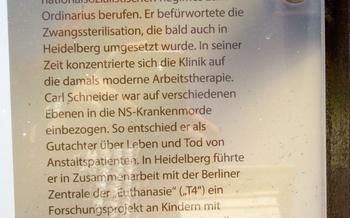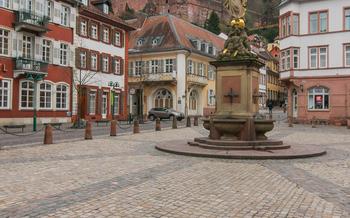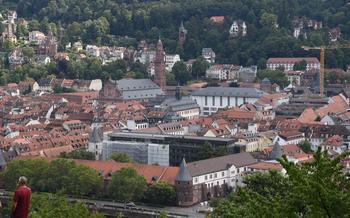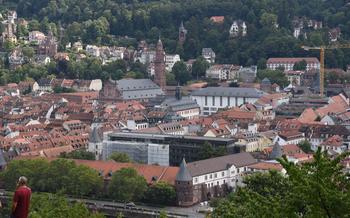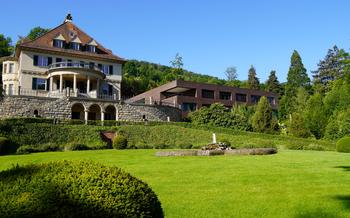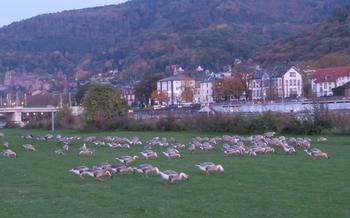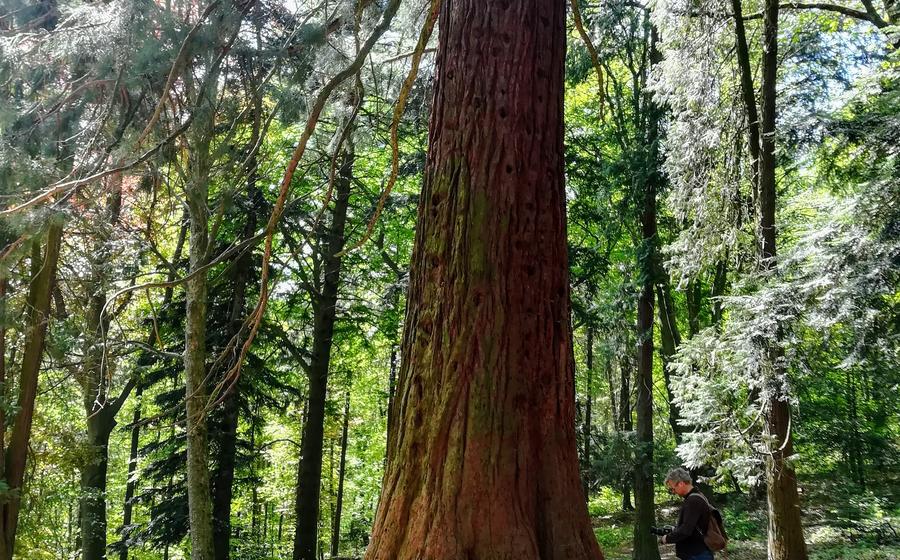
The University of Heidelberg Museum of Geosciences
- The University of Heidelberg Museum of Geosciences
- Exhibits and Collections
- Paleontology Section
- Mineralogy Section
- Petrology Section
- Stratigraphy Section
- Economic Geology Section
- Educational Programs
- Research Activities
- Museum Shop
- Accessibility
- Food and Drinks
- Nearby Attractions:
- Accommodation
- Insider Tip:
The University of Heidelberg Museum of Geosciences
The University of Heidelberg Museum of Geosciences is a treasure trove of knowledge and wonder, inviting visitors to explore the captivating world of Earth's natural history. Founded in 1750, the museum boasts a rich history, showcasing a diverse collection of geological specimens that unravel the intricate tapestry of our planet's past. Located in the heart of Heidelberg, Germany, the museum is a short walk from the iconic Heidelberg Castle, nestled amidst the picturesque Old Town. Easily accessible by public transportation, the museum offers a convenient and immersive experience for visitors of all ages.
With its captivating exhibits, the museum welcomes visitors from 10 am to 5 pm, Tuesday through Sunday. Admission fees are nominal, allowing everyone to delve into the wonders of geosciences. Guided tours, led by knowledgeable experts, are available upon request, providing an in-depth exploration of the museum's highlights and hidden gems. For further information and inquiries, visitors can reach the museum at +49 (0)6221 54-2414 or visit their informative website at www.uni-heidelberg.de/museum/geowissenschaften.
Exhibits and Collections
The University of Heidelberg Museum of Geosciences boasts a diverse and fascinating collection of exhibits covering various aspects of Earth sciences. Visitors can explore the wonders of the natural world through interactive displays, hands-on activities, and stunning visuals.
Highlights and Must-See Exhibits:
-
The Dinosaur Hall: Experience the grandeur of prehistoric giants as you come face-to-face with awe-inspiring dinosaur fossils. Learn about their evolution, behavior, and the fascinating world they inhabited millions of years ago.
-
The Mineral Gallery: Marvel at the beauty and diversity of minerals from around the globe. Discover the science of crystallography and gain insights into the properties and uses of various minerals in everyday life.
-
The Rock Garden: Explore the different types of rocks and their formation processes. Learn about the rock cycle and the forces that shape our planet's landscapes.
-
The Stratigraphy Exhibit: Journey through Earth's geologic history as you examine fossils, sedimentary rocks, and interactive displays. Understand the concept of geologic time and the evolution of our planet over millions of years.
-
The Economic Geology Section: Delve into the geology of mineral resources and their significance in our modern world. Explore exhibits on mining, mineral exploration, and the sustainable use of minerals.
Paleontology Section
Journey into the depths of time and explore the fascinating world of ancient life at the Paleontology Section of the University of Heidelberg Museum of Geosciences. Embark on a voyage through various geologic periods, witnessing the remarkable evolution of life on Earth. Discover an array of fossilized remains, from microscopic organisms to colossal dinosaurs that once roamed our planet.
Gain insights into the incredible diversity of life forms that have inhabited Earth, from the humble beginnings of single-celled organisms to the emergence of complex and magnificent creatures. Learn about the processes of evolution and extinction, and marvel at the intricate adaptations that allowed different species to thrive in diverse environments.
Among the highlights of the Paleontology Section are the impressive dinosaur exhibits. Gaze upon the towering skeletons of these prehistoric giants and learn about their unique characteristics and behaviors. Discover the fascinating world of marine reptiles, including ancient sea turtles, plesiosaurs, and ichthyosaurs, that once dominated the Earth's oceans.
For a more interactive experience, participate in hands-on activities and educational displays that bring the world of paleontology to life. Touch and examine real fossils, uncover the secrets of fossilization, and solve puzzles that test your knowledge of prehistoric life. Unleash your inner paleontologist and embark on an unforgettable journey through the annals of Earth's history.
Mineralogy Section
The Mineralogy Section of the University of Heidelberg Museum of Geosciences boasts an impressive collection of minerals from around the world. This diverse array of specimens showcases the beauty and variety of the Earth's mineral kingdom. Visitors can marvel at the intricate crystal structures, vibrant colors, and unique forms of these natural treasures.
Displays on crystallography and mineral properties provide insights into the science behind the formation and characteristics of minerals. Interactive exhibits and hands-on activities allow visitors to explore the physical and chemical properties of minerals firsthand. They can learn about crystal systems, cleavage, hardness, and other identifying features.
The section also highlights the practical applications of minerals in various industries. Exhibits showcase the use of minerals in jewelry, construction, electronics, and other fields. Visitors can learn about the extraction, processing, and sustainability of mineral resources.
Overall, the Mineralogy Section offers a fascinating journey into the world of minerals, providing a deeper understanding of their scientific significance and practical applications.
Petrology Section
The Petrology Section of the University of Heidelberg Museum of Geosciences delves into the fascinating world of rocks, exploring their diverse origins, compositions, and properties. Through captivating displays, visitors embark on a journey to discover the captivating stories hidden within each stone.
The section showcases an extensive array of rock specimens, carefully curated to represent the vast diversity of Earth's crust. From the fiery depths of volcanoes to the serene landscapes shaped by wind and water, each rock tells a tale of geologic processes and the evolution of our planet.
Exhibits on the rock cycle provide an immersive experience, illustrating the dynamic transformations that rocks undergo over time. Interactive displays and hands-on activities invite visitors to explore the processes of melting, cooling, and deformation that shape the Earth's surface.
Learn about the formation of metamorphic rocks, forged in the crucible of heat and pressure deep within the Earth's crust. Discover the secrets of igneous rocks, born from the fiery eruptions of volcanoes or the slow cooling of magma chambers.
The Petrology Section also sheds light on sedimentary rocks, composed of the remnants of ancient organisms, minerals, and rock fragments. These sedimentary layers hold clues to past climates, environments, and the evolution of life on Earth.
Whether you're a seasoned geologist or simply curious about the world beneath our feet, the Petrology Section offers an unforgettable journey into the realm of rocks, revealing the intricate processes that have shaped our planet over billions of years. So come, explore the wonders of petrology and gain a new appreciation for the diverse and captivating world of rocks!
Stratigraphy Section
The Stratigraphy Section of the University of Heidelberg Museum of Geosciences takes visitors on a journey through the Earth's geologic history. This section showcases an impressive collection of fossils, sedimentary rocks, and interactive displays that illustrate the formation of mountains and the evolution of landscapes.
Fossils, the preserved remains or traces of ancient organisms, provide valuable insights into the diversity of life that has existed on Earth over billions of years. The museum's collection includes fossils from various geologic periods, allowing visitors to trace the evolution of life from simple organisms to complex multicellular creatures.
Sedimentary rocks, formed from the accumulation and cementation of sediments, provide a record of past environments and events. The museum's displays showcase different types of sedimentary rocks, such as sandstone, limestone, and shale, and explain how they are formed and what they can tell us about the Earth's history.
The section also features interactive exhibits that allow visitors to explore the processes that shape the Earth's surface. Visitors can learn about the formation of mountains, the movement of tectonic plates, and the erosion and deposition of sediments that create the landscapes we see today.
Overall, the Stratigraphy Section of the University of Heidelberg Museum of Geosciences provides a comprehensive overview of the Earth's geologic history, from the formation of the first rocks to the evolution of the modern landscape.
Economic Geology Section
The Economic Geology Section of the University of Heidelberg Museum of Geosciences delves into the fascinating world of mineral resources and their significance in our daily lives. Through interactive displays and informative exhibits, visitors gain insights into the geology of mineral deposits, mining operations, and the sustainable use of Earth's resources.
Discover the diverse applications of minerals in various industries, from construction and manufacturing to electronics and energy production. Learn about the processes involved in mineral exploration and extraction, and the challenges faced in balancing economic development with environmental responsibility.
This section showcases a variety of minerals used in everyday products, such as gemstones, metals, and industrial minerals. Interactive exhibits allow visitors to explore the properties and uses of different minerals, and to understand how they are transformed into the materials we rely on.
The Economic Geology Section highlights the importance of mineral resources in our modern world, while emphasizing the need for responsible and sustainable practices in their extraction and utilization. It encourages visitors to reflect on the interconnectedness of geology, industry, and society, and to make informed choices as consumers and citizens.
Educational Programs
The University of Heidelberg Museum of Geosciences offers a wide range of educational programs tailored to schools, universities, and the general public. These programs aim to promote geoscience education, foster scientific curiosity, and inspire the next generation of geoscientists.
For schools, the museum provides guided tours, workshops, and educational materials aligned with curriculum standards. Students can explore the museum's exhibits, engage in hands-on activities, and learn about the fascinating world of geology. Workshops cover topics such as fossil identification, mineral properties, and the rock cycle, allowing students to delve deeper into specific areas of interest.
Universities and research institutions can collaborate with the museum on research projects, internships, and joint educational initiatives. The museum's extensive collections and research facilities offer valuable resources for students and researchers. Collaborative projects provide opportunities for students to gain hands-on experience, contribute to scientific research, and establish connections with leading experts in the field.
The museum also organizes public lectures, seminars, and summer camps for individuals of all ages. These programs provide a platform for geoscientists to share their knowledge and research findings with the community. Attendees can learn about the latest discoveries in geoscience, engage in discussions with experts, and gain a deeper understanding of the Earth's processes and history.
For educators and group bookings, the museum offers dedicated support and resources. Educators can access educational materials, lesson plans, and teaching guides to incorporate geoscience into their curriculum. The museum also provides assistance with group bookings, ensuring a smooth and enriching experience for students and visitors.
Research Activities
The University of Heidelberg Museum of Geosciences is not just a place of exhibition but also an active center for research and scientific inquiry. The museum's researchers are engaged in a wide range of projects, both within the museum's walls and in collaboration with other institutions around the world.
One of the ongoing research projects focuses on the geology of the Rhine-Neckar region. Researchers are studying the region's complex geological history, including the formation of the Rhine Graben and the volcanic activity that shaped the landscape. They are also investigating the region's mineral resources and the potential for geothermal energy.
Another area of research focuses on the evolution of life. Paleontologists at the museum are studying fossils from various geologic periods to learn more about the history of life on Earth. They are particularly interested in the evolution of dinosaurs and other prehistoric creatures.
The museum's researchers also collaborate with other institutions on projects related to climate change, natural hazards, and sustainability. They are working to understand the impact of human activities on the Earth's environment and to develop strategies for mitigating the effects of climate change.
The museum's research activities are supported by a variety of funding sources, including grants from the German Research Foundation (DFG), the European Union, and private foundations. The museum also offers internships and research opportunities for students and postdoctoral researchers.
For more information on the museum's research activities, please visit the museum's website or contact the research department directly.
Museum Shop
The University of Heidelberg Museum of Geosciences has a well-stocked museum shop that offers a wide range of souvenirs, books, and educational materials related to geology and Earth sciences. Visitors can find a variety of items, including fossils, minerals, rocks, posters, postcards, and books on various geological topics. The shop also offers a selection of children's books and educational kits, making it a great place for families to pick up some souvenirs and learning resources.
The museum shop is located in the museum's lobby and is open during the same hours as the museum. Visitors can pay for their purchases in cash or with major credit cards. The shop also has an online store where visitors can browse and purchase items from the comfort of their own homes.
Insider Tip:
The museum shop offers a 10% discount to students and seniors. Be sure to ask for the discount when you make your purchase.
Accessibility
The University of Heidelberg Museum of Geosciences is committed to providing an accessible and welcoming environment for all visitors. The museum is wheelchair accessible, with ramps and elevators available to all levels of the building. There are also designated parking spaces for visitors with disabilities located near the museum entrance.
Assistance with accessibility needs can be arranged by contacting the museum in advance. The museum also offers sign language interpreters and audio guides upon request. These services can be booked in advance or arranged on the day of your visit.
Additionally, the museum has a number of resources available for visitors with learning disabilities or sensory impairments. These resources include tactile maps, audio descriptions, and large-print materials.
The museum staff is always willing to assist visitors with any accessibility needs they may have. Please do not hesitate to contact the museum in advance or on the day of your visit if you require any assistance.
Food and Drinks
After a day of exploring the fascinating world of geosciences, you might find yourself in need of a culinary break. Within the museum, vending machines offer a quick and convenient option for snacks and drinks. However, to fully immerse yourself in the local flavors, venture outside the museum and explore the nearby culinary delights.
Heidelberg's Old Town is a treasure trove of culinary experiences. From traditional German restaurants serving hearty dishes like schnitzel and bratwurst to cozy cafes offering aromatic coffee and pastries, there's something to satisfy every palate. Don't miss the chance to sample local specialties such as Maultaschen, a type of filled pasta, or Dampfnudeln, sweet steamed dumplings.
For those seeking a more casual dining experience, the Neckar Riverbanks offer a serene setting for a picnic. Spread out a blanket and enjoy a leisurely meal surrounded by picturesque views of the river and the old bridge. Pack a basket filled with local delicacies, fresh fruits, and a bottle of wine for a truly memorable al fresco dining experience.
Nearby Attractions:
A visit to the University of Heidelberg Museum of Geosciences can be easily combined with other attractions in the picturesque city of Heidelberg. The Heidelberg Castle, perched atop a hill overlooking the Neckar River, is a must-see for any visitor to the city. Explore its ruins, marvel at the stunning views, and learn about its rich history.
Stroll through the charming Old Town, with its cobblestone streets, colorful buildings, and historic churches. Discover hidden courtyards, admire the intricate architecture, and soak up the vibrant atmosphere. Take a leisurely walk along the banks of the Neckar River, enjoying the scenic views and crossing the iconic Old Bridge.
For a unique perspective, join a guided tour or hop on a boat cruise to learn more about Heidelberg's history and landmarks. Don't miss the opportunity to explore the Philosophers' Walk, a scenic path along the Neckar River, which offers breathtaking views of the city and the surrounding hills.
For more information on nearby attractions, guided tours, and walking routes, visit the Heidelberg Tourism Office or the Heidelberg Visitor Center. They can provide you with maps, brochures, and recommendations to help you plan your visit.
Accommodation
When planning your trip to Heidelberg, you'll find a diverse range of accommodation options to suit every budget and preference. From cozy guesthouses and budget-friendly hostels to luxurious hotels with stunning views, there's something for every traveler.
For a truly immersive experience, consider staying in the heart of the Old Town. Here, you'll be surrounded by historic buildings, charming cafes, and lively bars. The Hotel Zum Ritter St. Georg is a popular choice, offering comfortable rooms and a convenient location just steps from the Heidelberg Castle.
If you're on a budget, there are several hostels and guesthouses that offer affordable rates. The Jugendherberge Heidelberg is a popular option, located near the Neckar River and offering stunning views of the city.
For those seeking a touch of luxury, Heidelberg offers several upscale hotels with world-class amenities. The Hotel Europäischer Hof Heidelberg is a renowned choice, boasting elegant rooms, a rooftop terrace with panoramic views, and a Michelin-starred restaurant.
To find the best deals and discounts, it's advisable to book your accommodation in advance, especially during peak tourist season. Online booking platforms like Booking.com and Expedia offer a wide selection of hotels and guesthouses with real-time availability and customer reviews.
No matter your budget or preferences, Heidelberg has something to offer every traveler. From budget-friendly options to luxurious stays, you'll find the perfect place to rest and recharge during your exploration of this charming city.
Insider Tip:
During my visit to the University of Heidelberg Museum of Geosciences, I stumbled upon a hidden gem tucked away in the Paleontology section. In a corner display, I discovered a remarkable fossil of a rare and well-preserved Archaeopteryx lithographica, commonly known as the "first bird." This feathered dinosaur, dating back to the Late Jurassic period, provided a breathtaking glimpse into the evolutionary transition from dinosaurs to birds. Its intricate details and the fact that it was uncovered in a nearby quarry made it a truly special find. Take your time exploring the exhibits, and don't hesitate to ask the friendly museum staff about hidden treasures or lesser-known highlights you might have missed.
